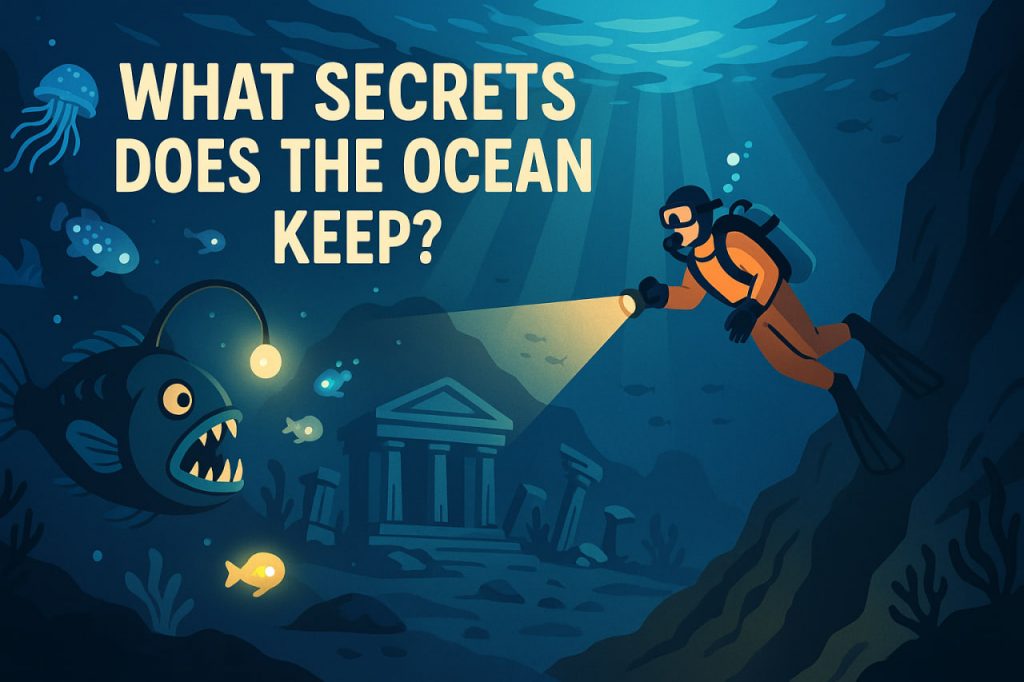The ocean covers more than 70% of Earth’s surface, yet humans have explored less than 10% of its vast depths. Beneath the waves lies a world as mysterious as outer space—a realm of hidden life, uncharted landscapes, and untold natural phenomena. From glowing creatures in the abyss to whispers of lost civilizations, the ocean remains one of Earth’s last frontiers. Its secrets continue to challenge scientists, inspire explorers, and remind humanity how little we truly know about our own planet.
The Unexplored Depths
The deepest point on Earth, the Mariana Trench, plunges nearly 11 kilometers (36,000 feet) below sea level—so deep that Mount Everest could fit inside it with room to spare. At these depths, the pressure is more than 1,000 times greater than at the surface, making exploration extremely difficult. Only a handful of crewed missions, such as those by James Cameron and Victor Vescovo, have reached the bottom. Despite harsh conditions, life thrives there—giant amphipods, translucent snailfish, and microorganisms that survive without sunlight. Scientists believe that millions of undiscovered species may inhabit these extreme environments.
The Mysteries of Deep-Sea Life
One of the ocean’s greatest secrets is the astonishing diversity of bioluminescent organisms—creatures that produce light through chemical reactions. In the perpetual darkness of the deep sea, these glowing signals serve as communication, camouflage, and even hunting tools. Some squid use flashing lights to attract prey, while others use them to vanish from predators by matching the faint glow of sunlight filtering from above. Marine biologists estimate that up to 90% of deep-sea species may possess bioluminescence, creating what could be described as an underwater galaxy of living stars.
Sunken Civilizations and Lost Worlds
Throughout history, the ocean has swallowed entire cities and civilizations. Ancient coastal settlements, such as Heracleion near Egypt and Dwarka off the coast of India, were lost to rising seas and natural disasters. Modern archaeological dives have uncovered temples, statues, and artifacts preserved beneath layers of sand and coral. Some historians believe that legends like Atlantis may have roots in real events—perhaps ancient cities destroyed by tsunamis or shifting tectonic plates. These underwater ruins offer a haunting glimpse into humanity’s fragile relationship with nature.
The Ocean’s Influence on Climate and Life
Beyond its mysteries, the ocean plays a vital role in maintaining Earth’s balance. It absorbs 30% of carbon dioxide emissions and regulates global temperature through vast currents such as the Gulf Stream. Deep below, hydrothermal vents—cracks in the ocean floor that emit mineral-rich water—host entire ecosystems powered not by sunlight but by chemical energy. Studying these vents has helped scientists understand how life might exist on other worlds, such as the icy moons of Jupiter and Saturn. The ocean, in many ways, is a window into both Earth’s past and the universe’s potential.
Strange Sounds and Unexplained Phenomena
For decades, oceanographers have recorded eerie underwater sounds that defy explanation. The most famous, known as “The Bloop,” was detected in 1997 and initially suspected to come from a massive sea creature. Later analysis suggested it was caused by ice fracturing in Antarctica—but many still wonder. Other phenomena, such as underwater brine pools, methane seeps, and black smokers, continue to puzzle researchers. Some of these alien-looking environments harbor bacteria capable of surviving conditions thought impossible for life.
The Threats and the Future
While the ocean hides beauty and mystery, it also hides growing danger. Plastic pollution, acidification, and overfishing are altering its ecosystems faster than they can recover. Scientists warn that many of the ocean’s secrets could vanish before they are even discovered. Yet new technologies—autonomous submarines, deep-sea drones, and DNA sequencing—offer hope for exploration and conservation. By protecting the ocean, humanity may preserve not only biodiversity but also answers to fundamental questions about life and survival.
Expert Perspectives
Experts such as Dr. Sylvia Earle, a renowned marine biologist, call the ocean “Earth’s life support system.” She and others emphasize that the secrets of the deep are not just scientific curiosities but vital keys to understanding the planet’s health. Oceanographers like Dr. Robert Ballard, who discovered the Titanic wreck, believe that the deep sea still holds countless shipwrecks and possibly new geological formations. Meanwhile, climatologists study deep-sea sediments to reconstruct ancient climates, revealing that the ocean’s memory stretches back millions of years.
Interesting Facts
- More than 80% of the ocean remains unmapped and unexplored.
- The pressure in the Mariana Trench is equivalent to the weight of 50 jumbo jets pressing on one person.
- The ocean contains mountain ranges, volcanoes, and rivers of brine beneath the surface.
- Scientists have discovered fish that can survive in total darkness at temperatures near freezing.
- Less than 5% of shipwrecks on the ocean floor have been found or studied.
Glossary
- Bioluminescence – The production of light by living organisms through chemical reactions.
- Hydrothermal Vent – A fissure on the seafloor that emits heated, mineral-rich water.
- Brine Pool – A dense underwater lake of salty water found on the seafloor.
- Methane Seeps – Areas where methane gas escapes from beneath the ocean floor.
- Acidification – The increase in ocean acidity due to absorption of atmospheric CO₂.
- Gulf Stream – A warm ocean current that influences climate across the Atlantic.
- Tectonic Plates – Large pieces of Earth’s crust that move and shape the planet’s surface.
- DNA Sequencing – A method for identifying organisms by analyzing genetic material.
- Sediments – Layers of particles deposited over time at the bottom of oceans or lakes.
- Carbon Sink – A natural system that absorbs and stores carbon dioxide from the atmosphere.


